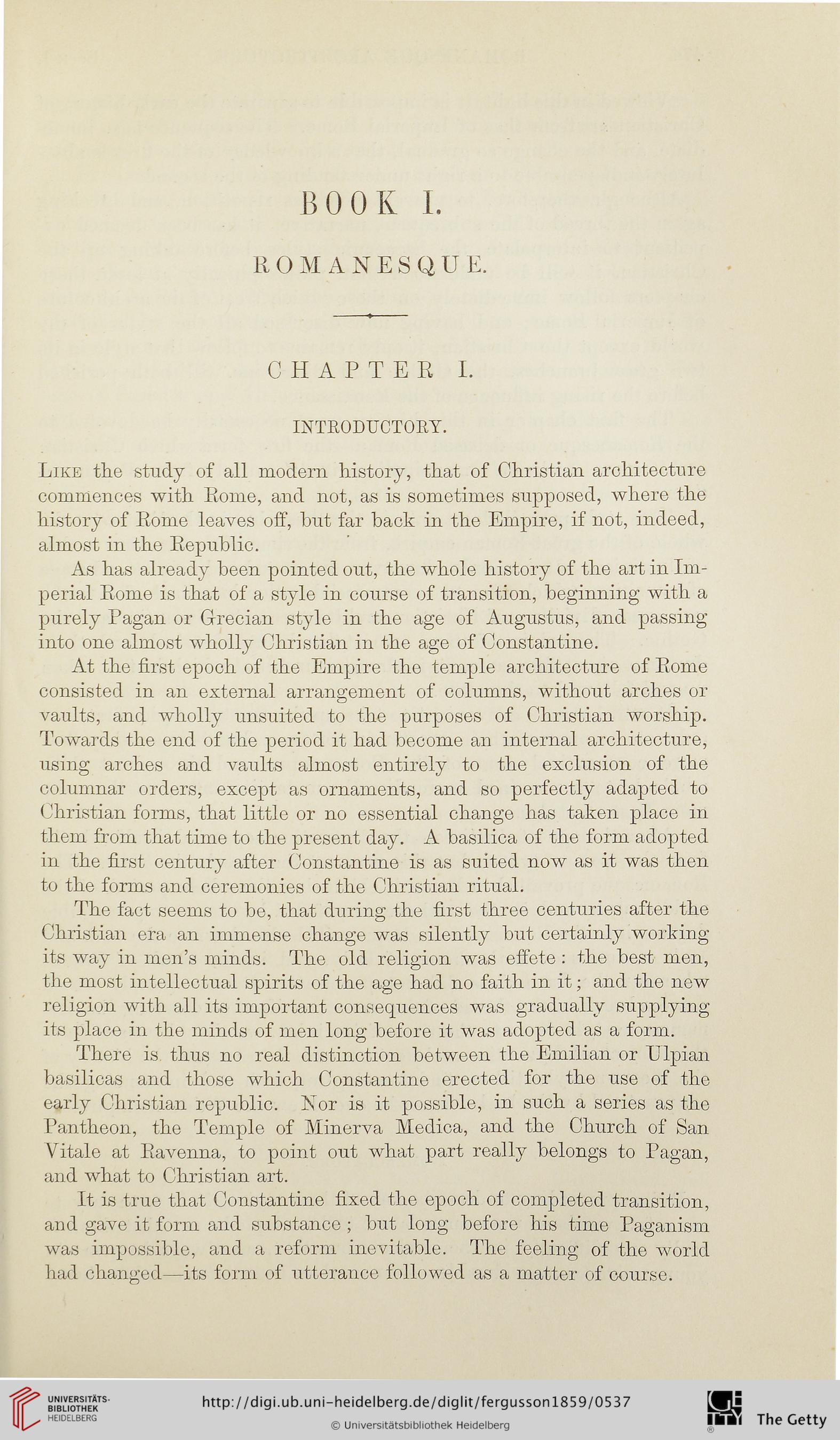BOOIv I.
ROMANESQUE.
CHAPTER I.
INTRODUCTORY.
Like the study of all modern history, that of Christian architectnre
cominences with Rome, and not, as is sometimes snpposed, where the
history of Rome leaves off, hnt far back in the Empixe, if not, indeed,
almost in the Republic.
As has already been pointed out, the whole history of the art in Im-
perial Rome is that of a style in course of transition, beginning with a
purely Pagan or Grecian style in the age of Augustus, and passing
into one almost wholly Christian in the age of Constantine.
At the first epoch of the Empire the temple architecture of Rome
consisted in an extemal arrangement of columns, without arches or
vaults, and wholly unsuited to the purposes of Christian worship.
Towards the end of the period it had become an internal architecture,
using arches and vaults almost entirely to the exclusion of the
columnar orders, except as ornaments, and so perfectly adapted to
Christian forms, that little or no essential change has taken place in
them from that time to the present day. A basilica of the form adopted
in the first century after Constantine is as suited now as it was then
to the forms and ceremonies of the Christian ritual.
The fact seems to be, that during the first three centuries after the
Christian era an immense change was silently but certainly working
its way in men’s minds. The old religion was effete : the best men,
the most intellectual spirits of the age had no faith in it; and the new
religion with all its important consequences was gradually supplying
its place in the minds of men long before it was adopted as a form.
There is thus no real distinction between the Emilian or Elpian
basilicas and those which Constantine erected for the use of the
early C'hristian republic. Nor is it possible, in such a series as the
Pantheon, the Temple of Minerva Medica, and the Church of San
Yitale at Ravenna, to point out what part really belongs to Pagan,
and what to Christian art.
It is true that Constantine fixed the epocli of completed transition,
and gave it form and substance ; but long before his time Paganism
was impossible, and a reform inevitable. The feeling of the world
had changed—its form of utterance followed as a matter of course.
ROMANESQUE.
CHAPTER I.
INTRODUCTORY.
Like the study of all modern history, that of Christian architectnre
cominences with Rome, and not, as is sometimes snpposed, where the
history of Rome leaves off, hnt far back in the Empixe, if not, indeed,
almost in the Republic.
As has already been pointed out, the whole history of the art in Im-
perial Rome is that of a style in course of transition, beginning with a
purely Pagan or Grecian style in the age of Augustus, and passing
into one almost wholly Christian in the age of Constantine.
At the first epoch of the Empire the temple architecture of Rome
consisted in an extemal arrangement of columns, without arches or
vaults, and wholly unsuited to the purposes of Christian worship.
Towards the end of the period it had become an internal architecture,
using arches and vaults almost entirely to the exclusion of the
columnar orders, except as ornaments, and so perfectly adapted to
Christian forms, that little or no essential change has taken place in
them from that time to the present day. A basilica of the form adopted
in the first century after Constantine is as suited now as it was then
to the forms and ceremonies of the Christian ritual.
The fact seems to be, that during the first three centuries after the
Christian era an immense change was silently but certainly working
its way in men’s minds. The old religion was effete : the best men,
the most intellectual spirits of the age had no faith in it; and the new
religion with all its important consequences was gradually supplying
its place in the minds of men long before it was adopted as a form.
There is thus no real distinction between the Emilian or Elpian
basilicas and those which Constantine erected for the use of the
early C'hristian republic. Nor is it possible, in such a series as the
Pantheon, the Temple of Minerva Medica, and the Church of San
Yitale at Ravenna, to point out what part really belongs to Pagan,
and what to Christian art.
It is true that Constantine fixed the epocli of completed transition,
and gave it form and substance ; but long before his time Paganism
was impossible, and a reform inevitable. The feeling of the world
had changed—its form of utterance followed as a matter of course.




